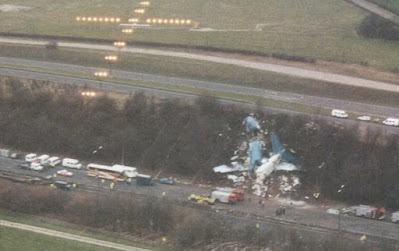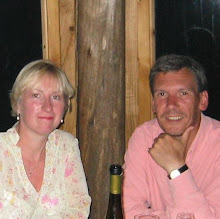This has got nothing to do with Kyles or Western Isles but it’s another subject I’m interested in and I found myself writing this to try and make sense of it in my own mind so I’ll just publish it here anyway.
So, video of the plane on its original final approach shows a puff of smoke and flame from the RIGHT engine consistent with bird strike.
Moments later the pilot tells control: “Mayday, Mayday, Mayday, bird strike, bird strike, going around”
First thing puzzling the YouTuber 737 captains (Dennis is very good) is: why did they decide to go around (overshoot the runway) instead of continuing to land?
Second puzzle is that a bird strike, even one which wrecks an engine, is a not a Mayday because a 737 is perfectly capable of flying on one engine so there’s no immediate danger.
One minute later, the pilot tells control he’s going to land on the same runway from the other end, do a U-turn, in other words. The experts will tell you that’s a very bad idea, unless absolutely necessary, due to the risk of making an arse of it by doing things in a hurry.
The decision to do a U-turn suggests that, in fact, the plane had lost BOTH engines and therefore going the long way round to land in the original direction wasn’t an option.
This is corroborated by the fact that the experts are saying that you can see from the landing video that the LEFT engine appears not to have been running when it landed (no exhaust visible) whereas the RIGHT one (the one the earlier video showed emitting a puff of smoke and flame) appeared to be running (visible exhaust) although we can’t tell how much thrust it was delivering – maybe not much at all.
The second (left) engine might have been lost from a subsequent bird strike not caught on camera. Or it might be that the pilots misidentified the engine which had been hit and shut down the good engine (that’s happened before – British Midland at Kegworth (East Midlands) in 1988.)
And we know that the plane landed with its flaps
and wheels up. That could be because, in their haste to land from a U-turn, the
pilots simply forgot to lower them. Or it might be that, with insufficient
thrust from either engine, there wasn’t enough hydraulic pressure to lower
them. (Wheels – but not flaps – on a 737 can be lowered without hydraulics by
pulling a rip cord on the cockpit floor which opens the hatches and lets them
drop out by gravity. But apparently, this can’t be reached from sitting in the
pilots’ seats so maybe no time to get up and do it when you’re performing a
U-turn.)
Kegworth 1988 - didn't reach the runway and hit motorway embankment. Lucky not to burst into flames
But there was apparently enough hydraulic pressure available to control the plane’s ailerons and elevators to direct it onto the runway at the right attitude so the other (more likely?) possibility about why no wheels or flaps is that they were deliberately kept up because, with no (or not enough) power from either engine, the pilots wanted to keep the plane as aerodynamically ‘clean’ as possible so that it would glide as far as possible to reach the runway and not land short of it.
And finally, the plane landed very far down the runway. No doubt very difficult to plant it on the correct spot when you’re going very fast due to no flaps. If it had landed in correct place, it MIGHT have been going a bit slower when hit that concrete bund with the antennae and there MIGHT have been fewer fatalities. (I gather a plane will take much longer to slow down skidding along its bottom than rolling on its wheels with its brakes applied – do pilots get trained that?)
So two overall possibilities: the pilots apparently disregarded all their training and made a complete and utter howling fuck of the whole thing from the moment of the (first?) bird strike – went around when they should have continued to land; did a U-turn when they should have gone all the way round (or had to do a U-turn because they shut down the wrong engine); and in their haste, forgot to put the flaps and wheels down again …
Or, more charitably, they erred by not continuing to land and going around instead but then, after that mistake was irretrievable, found themselves with no (or very little) power due to multiple bird strikes so HAD to do a U-turn and keep the flaps and wheels up to ‘stretch the glide’. But unfortunately, just stretched it a little too far, which might be forgivable under pressure.
The latter is the more plausible scenario, I think. (I’m thinking about the British Airways 777 which lost power on approach to Heathrow in 2008. The co-pilot there managed to ‘stretch the glide’ almost to perfection by pulling up the flaps (but not the wheels because that would have momentarily created more drag as the wheel well hatches opened) and dropped it onto the grass at the near end of the runway which wrote off the aeroplane but with no loss of life or even serious injury.)
What about Sully, Miracle on the Hudson? He lost
both engines due to multiple bird strikes. He judged he was too far away from
the runway he’d just taken off from to do a U-turn back to it so he landed on
the river where there were no obstacles to hit. Maybe the Korean pilots should
have aimed for the sea instead (easy to be wise with benefit of hindsight).
Maybe the takeaway from this accident is that, if you find yourself with no
power, don’t aim for a runway where there’s too much of a risk of getting it
slightly wrong and hitting something around the runway. Instead aim for open
water (or, I gather, landing on trees if you can’t make a runway is very
effective because they break up the momentum by the branches ripping off the
wings and engines and whatnot but leaving the fuselage intact. Don’t try it at
home, though.)
BA38 almost made it to the runway
We haven’t mentioned the concrete bund thing at the end of the runway the plane crashed into. That’s what killed everybody. I get the argument that runs: (1) runways are designed so that you can stop in their length and if you can’t do that, then don’t try to land on them; and (2) if you’re going to keep space clear around a runway, you might as well tarmac over it to build a longer runway (in relation to which point (1) will then re-apply). But on balance, I think I’d be in favour of not gratuitously putting obstacles around a runway unless absolutely necessary. I gather these antennae don’t need to be mounted on anything and are themselves designed to be ‘frangible’ (breakable if hit by anything heavy like a 737).




Neil, an excellent concise summary of what is known so far of this tragedy which could/should have been a non-event. I'd read that the ILS localiser antennas were mounted on a concrete slab on top of the bund to avoid flooding. A bizarre choice given the option of longer/taller frangible masts.
ReplyDeleteIn addition to Dennis on YouTube, I presume you are already aware of Juan Browne's 'Blancolirio' channel plus the excellent deep-dive accident reviews by Petter Hornfeldt AKA "Mentour Pilot".
Thanks Roy. The more I think about this, the more I come back to what prompted them to go-around? Unless they just panicked (and the issuing of the Mayday may be evidence of that), there must have been something else going on that YouTube guys haven't identified yet.
DeleteYes, am familiar with Blancolirio and Mentour (although I tend to find the latter's a bit over long. For me, the ideal YT is 10-15 minutes.)
As I gather you're interested, are you aware of Stefan Buntenbach 'Approach and Departure Videos'? The best in-cockpit videos by some distance because he has multiple cameras focussed on the instruments as well as the outside views. As well as being a nice friendly chap who always answers any questions you ask.